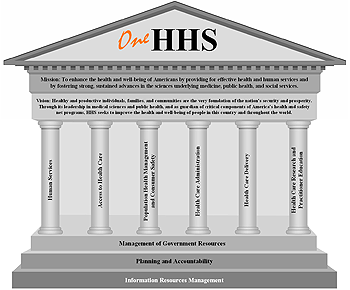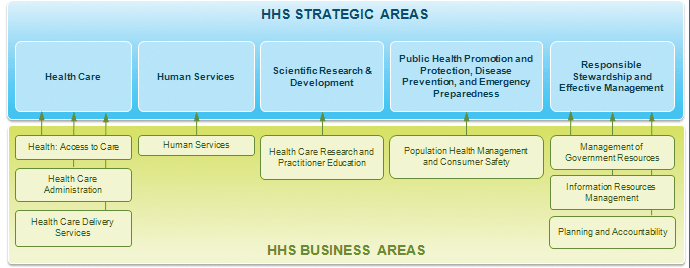HHS is a large and diverse organization, with a broad mission and corresponding functional responsibilities at both the Department level and, especially, among the Operating Divisions. To improve the business-driven perspective necessary for effective enterprise architecture development in support of the HHS mission, the HHS EA Program has adopted an approach defined in terms of Business Functions and Segments. Business Functions are grouped as communities of interest according to similarities in mission, goals, objectives, and commonality of services and business processes. HHS defines nine Business Areas:

HHS Business Areas (Click to enlarge)
HHS Business Areas
- Access to care
- Health care Delivery Services
- Health Care Research & Practitioner Education
- Human Services
- Population Health Mgmt & Consumer Safety
- Information Resources Management (IRM)
- Management of Government Resources
- Planning & Accountability
The segment-based approach helps to make enterprise architecture more manageable and consistent across HHS and its operational divisions. This business-driven perspective is also consistent with the EA guidance provided by OMB. The HHS EA Program’s incorporation of segment-based EA development principles helps to establish appropriate governance boundaries and dimensions for EA development, use, and analysis.
The diagram below shows the alignment of the HHS EA Business Areas to the HHS Strategic Goals as described in the HHS Strategic Plan.

HHS has developed a comprehensive Architecture Development Methodology (ADM) that describes in detail all phases of segment development, processes and activities to be followed; data collection templates, tools, and guidelines; and recommendations and guidelines for producing specific artifacts and work products. The ADM provides a structured, repeatable set of processes to guide the collection of segment-related information and production of segment-related artifacts and other EA outputs. This information has many possible uses, including business process analysis and re-engineering, and support for decision making related to proposed IT investments intended to build or acquire a solution to address one or more business needs as defined in the segment’s target architecture.
The expansive detail in the ADM makes it a valuable tool for architects and others actively involved in segment architecture development, but its size and scope makes it unsuitable to serve as a general introduction to segments and segment architecture development at HHS. This Segment Architecture Overview and Guide – in contrast to the ADM, the HHS Segment Architecture Concept of Operations, and other documents published by the HHS EA Program – is intended to provide an introduction to segment architecture development at HHS, and to serve as the first point of reference for anyone wishing to learn about HHS segment architecture activities. As such, it presents an overview of the segment architecture development process, major activities, required and recommended outputs, and general expectations for segments under development. This document does not provide step-by-step instructions for conducting segment architecture development, but instead refers to the ADM and other relevant documentation for those seeking more detailed guidance.